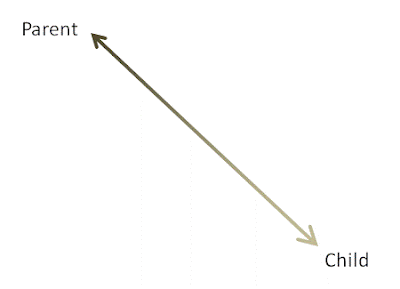Relationships and Influence
What is influence and how is it measured? You are not going to find the answer for your brand in your current CRM system. The flaw in current collection and analysis of relationships is the organization that a relationship data is comprised simply of the two end points. What else could it be?
The state of the art of relationship models either classifies relationships as peer-to-peer or parent-child relationships.
Notice there are no measures of influence. These models assume that in peer-to-peer relationships influence is mutually even and in parent-child relationships influence is purely one way. Since neither of these relationship models collect real influence, you can’t analyze it nor contribute to its growth.
Who can claim the relationship between parent and child is only one way? Even at the beginning when the parent may control the location of the child, the child still controls the meal schedule. Also look at the relationship between dictators and their subjects. On the surface it may seem that control is only one way, but even dictators recognize that their subjects can rise up against them if they are not serving the needs of the people. In other words, the populous also has some control. Let’s use another name for control: influence. A parent-child relationship with a measure of influence is better expressed this way:
Where the relationship from the parent to the child shows higher influence then from the child to the parent. Notice there are still two ends to the relationship; however, there is also the measure of influence in each direction. This view allows for breaking free from the static constructs above and recognizing that the labels of relationship types of parent-child or peer-to-peer are simply the extremes of a continuity of possible relationships.
Dictators have more influence then senators, but an electorate also has influence and it is more then subjects. With our best friends, we share evenly. Notice that when influence is even it can be even-and-slight or even-and-strong.
Owners have more influence over their own purchase then they have over the brand in general but can still have some influence over a new prospect for the brand. Especially for marketers, simply having relationships recorded as end points in the CRM system is not enough. The same applies to any CRM end user, e.g. customer service or loyalty programs. The CRM system must also record the influence from each end to the other. But are the ends simply people? No.
Influence and Persona
Recognize that influence is situational dependent. At work my boss has more influence over the work of the other members of the team then I do. However, when we have a team lunch, I have more influence because I have sampled a wider variety of local eating joints. During our free time neither of us has much influence over the other. What does this example show? That influence is between personas. My boss has more influence over my work persona then I have over his. My team fun persona has more influence than his. And our home personas have no influence over each other’s.
The CRM system must also measure personas in order to have the right end points for the influence measure. This allows it to maintain multiple relationships between individuals. And it must have the capacity to store influence in both directions for each relationship.
Six Degrees of Influence
What else can you do once you start measuring relationships through influence and personas? Rather then find clusters of relationships and assume common interests, you should be discovering spheres of influence or paths of influence from one to another. These are the sources you should rely on to recruit sources of positive influence for your brand.
So measure influence, but recognize influence is a two way relationship that does not need to be even. Allow more then one relationship between people based on personas. Once you start measuring relationships via influence, then you have the means to determine how to grow the the totality of influence between the members of your brand in order to grow loyalty to the brand and so the brand, overall.





